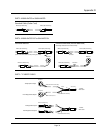
320A
Compellor
Page 36
Appendix F
Digital–vs–Analog; Peak–vs–RMS
How To Deal With The Confusion
By Donn Werrbach • 10/03/03
The Confusion
The matter of audio level measurements and specifications can be very confusing at times.
That is because some specs relate to peak measurements and some to average or RMS
measurements. There is no one standard in use throughout the industry.
Where The Problem Comes From
Any sound’s tonality and intelligence is conveyed by the details of specific frequency com-
ponents, and those components’ phase and amplitude relationship. Sounds contain not only
harmonics in varying amounts, but also may contain unrelated frequency components. These
all add up to create complex and varying audio waveforms.
If all sound were nothing but pure simple sine waves (the most fundamental wave of nature),
the measurement of sound would be very simple. Measurements, whether peak weighted or
average weighted, would almost come out the same. A sine wave’s peak level is only 3dB
higher than it’s average level, and what’s more important, the ratio of peak to average, also
called the “crest factor”, is always the same no matter what the level is. Both peak and aver-
age level meters could be calibrated in the same relative units (like VU) and would read the
same.
However, since sound waves are complex, their peak to average ratio varies depending on
the sound characteristics, and that ratio can vary from 3dB to as much as 15dB. So, in the real
world, peak and average meters will disagree by as much as 15dB. The ear hears loudness
based on the power level contained in a sound wave. The power level is proportional to the
average signal level, so averaging meters will respond to level more like our hearing. Peak
measurement of audio cannot infer the volume level except with pure test tones because the
crest factor of program audio is large and variable, kicking the peak meter well above the
average measurement.
The problem is that we find both kinds of meters in use and they cannot be easily recon-
ciled.
Dueling Standards
The PPM Standard
Throughout Europe, and its sphere of influence in the world, professional analog standards
have been based upon some form of peak audio measurement. One of the most popular
standards is the German DIN Peak Program Meter (PPM). These are found on recording
consoles, program line meters, tape recorders, and everywhere else. These meters have a
10 millisecond peak integration time and several seconds of fallback time. As a result, not all
transient peaks are captured by the meter, but the readings tend to ride atop the typical peak
level, totally disregarding the average level.
An advantage of this method is that audio electronics need not be built with very much head-
Appendix F


















